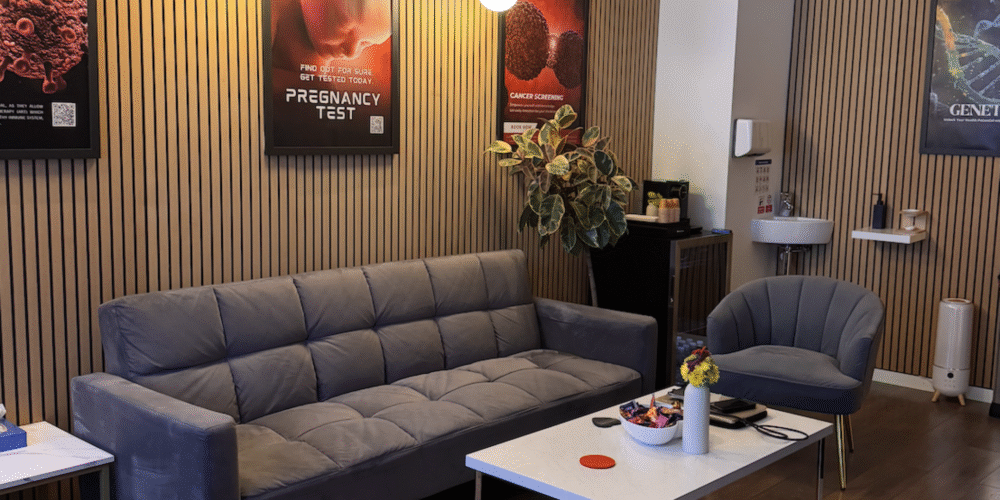
Why In-Clinic Blood Tests Are More Accurate Than At-Home Kits
By Tharb Faisl
In recent years, at-home blood test kits have become increasingly popular. They promise convenience and privacy, offering results with a simple finger-prick and postal return. While these kits can provide a useful starting point, they are not a substitute for the accuracy and reliability of in-clinic blood testing carried out in a professional laboratory setting.
For individuals who want precise answers about their health, particularly nutrition and vitamin status, the difference between home testing and a clinic-based approach is significant.
The Rise of At-Home Blood Test Kits
At-home kits appeal to people looking for quick answers. Most of them use capillary blood (a small drop from a finger-prick). The sample is either processed by the individual using a simple device or sent by post to a laboratory for analysis.
Typical kits measure:
- Vitamin D
- Vitamin B12
- Iron / Ferritin
- Magnesium
- Basic cholesterol panels
They can provide general insights, but they cannot match the scientific precision and control of in-clinic testing.
Why Clinic Blood Testing is More Scientifically Reliable
1. Venous vs Capillary Sampling
In clinics, blood is taken from a vein by a qualified phlebotomist, nurse or a doctor. Venous blood samples are the gold standard for laboratory testing. They provide enough volume for multiple tests and are less prone to contamination.
Capillary samples from finger-pricks, used in home kits, can be diluted with tissue fluid or affected by poor technique. This increases the risk of false low or inconsistent readings.
2. Sample Handling and Transport
In a clinical environment, blood samples are:
- Correctly labelled and processed immediately
- Stored and transported under controlled temperature conditions
- Separated into serum or plasma quickly to prevent degradation
With home kits, samples often sit in the post for 24 – 48 hours. During this time, factors such as temperature changes, vibration, and clotting can alter results, especially for sensitive vitamins and minerals.
3. Range of Tests Available
In-clinic blood testing can measure a wide range of health markers, including:
- Full vitamin and mineral panels (D, B12, folate, magnesium, iron, zinc)
- Hormones (thyroid, testosterone, oestrogen, cortisol)
- Inflammatory markers (CRP, ESR)
- Advanced nutrition and metabolism tests
Most at-home kits are limited to a smaller set of nutrients. If further investigation is needed, you would still need to attend a clinic for a venous draw.
4. Laboratory Standards and Quality Control
Clinical laboratories operate under strict quality systems. Every test runs alongside control samples and calibration checks.
This means results are:
- Traceable to international reference standards
- Repeatable with minimal error margin
- Interpreted by qualified specialists
Home kits may use accredited labs for final analysis, but the sample quality is already compromised before it even arrives.
5. Expert Interpretation
Numbers on their own can be confusing. For example, a vitamin B12 level of 200 pmol/L may be considered “borderline” – but whether it is a problem depends on symptoms, diet, medications, and other blood markers.
In a clinic, results are reviewed in context. You can receive:
- A clear explanation of what results mean for your health
- Guidance on safe supplementation or lifestyle changes
- Recommendations for follow-up testing if required
At-home kits often only provide a PDF report with limited explanation.
6. Accuracy and Reproducibility
In scientific testing, the margin of error matters. Clinics use venous samples, duplicate measures, and strict QA protocols, which reduce errors.
At-home kits depend heavily on user technique. A small mistake – squeezing the finger too hard, under-filling the sample, or exposing it to heat – can cause a significant difference in results.
When At-Home Blood Kits Can Be Useful
At-home kits do have a role. They can be:
- A convenient first step for people curious about nutrition
- A way to track changes over time (if using the same provider and method)
- Helpful for identifying gross deficiencies, such as very low vitamin D
However, they should be treated as screening tools – not definitive diagnostic tests.
Why Choose In-Clinic Blood Testing
Choosing an in-clinic service ensures:
- Immediate sample handling under professional standards
- Comprehensive panels that go beyond basic vitamins
- Accurate and reliable data suitable for medical decisions
- Qualified interpretation with personalised advice
- Peace of mind knowing results are precise and clinically valid
If you are making decisions about your health – whether it is starting supplements, investigating fatigue, or managing a medical condition – accurate testing is essential.
Common Questions
At-home blood kits are convenient, but convenience should never outweigh accuracy when it comes to your health. In-clinic blood testing offers scientifically validated results, expert interpretation, and the reassurance that comes from professional healthcare standards.
If you are serious about understanding your nutrition, vitamins, and overall health, the best option remains professional blood testing at a trusted clinic.











